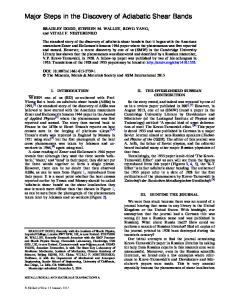Adiabatic shear band formation in Al-SiC w composites
- PDF / 1,764,028 Bytes
- 6 Pages / 597.28 x 785 pts Page_size
- 32 Downloads / 365 Views
I.
INTRODUCTION
ADIABATIC shear band is a term describing the narrow region o f highly localized plastic deformation, which has been observed when materials are deformed at high strain rates, for example, in machining, high speed metal forming, and ballistic impact. [1,2,3] Formation o f the adiabatic shear band is believed to be initiated due to development o f thermomechanical plastic instability.[4-7j It has been reported that the localized deformation occurs more readily in materials with l o w strain hardening r a t e , low strain rate sensitivity, l o w thermal conductivity, and high thermal softening rate. [2-11] Localization generally induces failure o f structural components through a loss in load-carrying capacity within the shear band. [7.8] Hence, adiabatic shear banding formed by ballistic impact is o f great interest, since it is known to be a precursor to armor and projectile failure. Recently, SiC w h i s k e r reinforced aluminum (A1-SiCw) composites have been considered as potential armor materials, since they have high elastic modulus and strength combined with light weight. However, there is no information on the deformation characteristics o f A1-SiCw composites under ballistic impact loading. The aim o f the present study is to elucidate a more fundamental understanding on how the adiabatic shear band develops in SiC whisker reinforced aluminum composites upon ballistic impact. The role o f whiskers was brought into focus, and their importance in high rate deformation processes was emphasized. The effect o f these reinforcements was compared using two composites with different volume fractions. Furthermore, the shear banding behavior was discussed in comparison to dynamic fracture toughness, w h i c h is another important p a r a m e ter characterizing ballistic properties. SUNGHAK LEE, Associate Professor, and KI C H O N G KIM, Research Assistant, are with the Depa:lment of Materials Science and Engineering, Pohang Institute o f Science and Technology, Pohang, 790-600 Korea. KYUNG-MOX CHO, Assistant Professor, is with the Department of Metallurgical Engineering, Pusan National University, Pusan, 709-735 Korea. WON BONG CHOI, Research Scientist, is with the Advanced Technical Research Center, Agency for Defense Development, Dajeon, 300-600 Korea. Manuscript submitted February 4 , 1992. METALLURGICAL TRANSACTIONS A
II.
EXPERIMENTAL
The materials used in this study were powder metallurgy processed 2124 A1 composites reinforced with 7 and 20 vol pct SiC whiskers. These materials were purchased from Advanced Composite Materials Corporation, Greer, SC, in the form o f 13 x 127 mm extruded r e c t angular bar. The composites were then solution-treated at 510 °C for 4 hours, w a t e r quenched, and subsequently aged at 177 °C. The peak aging (T6) condition was determined to be 5 hours for the 7 vol pct w h i s k e r reinforced composite and 3 hours for the 20 vol pct composite by measuring microhardness o f the matrix as a function o f aging time. Room-temperature tensile properties o f the comp
Data Loading...











